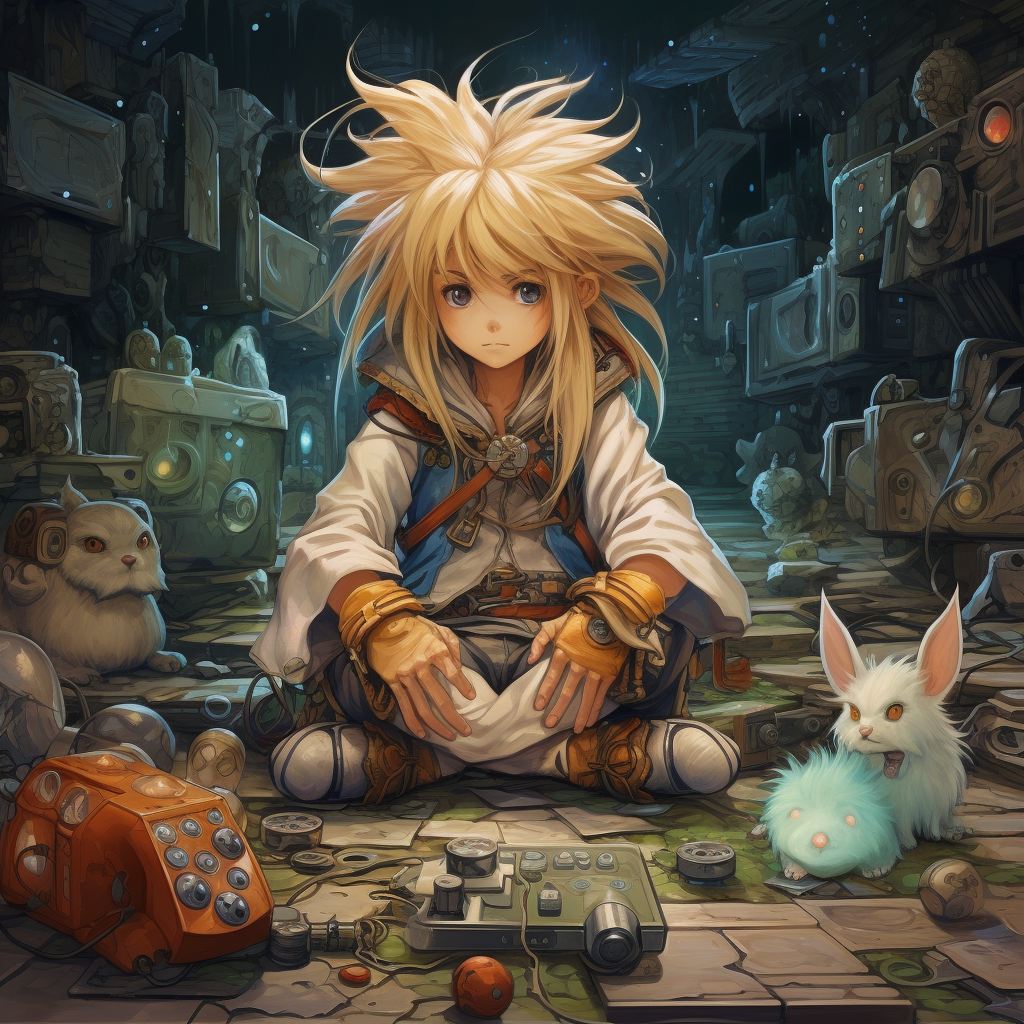Welcome to our AI/ML Lab
Exploring Artificial Intelligence and Machine Learning in Video Game Development
In the rapidly evolving realm of video game development, the incorporation of Artificial Intelligence (AI) and Machine Learning (ML) has become a game-changer, transforming the way games are created, played, and experienced. The ‘why’ behind this integration stems from the pursuit of more immersive, interactive, and captivating gaming experiences. AI/ML techniques empower developers to create intelligent Non-Player Characters (NPCs) that learn and adapt, generate limitless unique content, predict and respond to player behavior, and even assist in automating game testing. Leveraging these technologies, developers can craft dynamic and personalized gaming environments that keep players engaged like never before. Whether you’re a game developer, player, or enthusiast, understanding the ‘what’, ‘why’, and ‘how’ of AI/ML in game development offers a fascinating insight into the future of gaming.


What is AI/ML in Video Game Development?
Artificial Intelligence (AI) and Machine Learning (ML) in video game development encompass a variety of technologies and techniques used to create more dynamic, adaptive, and engaging gaming experiences. AI, at its core, involves designing computer systems to simulate human intelligence, making decisions and performing tasks that would normally require human cognition. In the context of video games, this might include controlling non-player characters (NPCs), generating dialogue, or designing complex gameplay systems. Machine Learning, a subset of AI, involves creating models that can learn and improve from experience. In video games, this could involve anything from training NPCs to improve their strategies over time using techniques like reinforcement learning, to creating predictive models to anticipate player behaviors, to employing neural networks for procedural content generation. Essentially, the ‘what’ of AI/ML in video game development is about leveraging advanced computational techniques to create more intelligent, interactive, and engaging gaming experiences.




How is AI/ML used in Video Game Development?
In video game development, several types of AI and ML are employed to deliver dynamic, engaging, and immersive gaming experiences. For AI, these include Finite State Machines and Behavior Trees, which define the decision-making processes and actions of non-player characters (NPCs), making them appear more intelligent. Pathfinding algorithms like A* are used to navigate game worlds efficiently. On the machine learning front, Reinforcement Learning is leveraged to train agents through a system of rewards and penalties, enabling NPCs to learn and adapt their strategies. Generative models, like Generative Adversarial Networks (GANs) and Variational Autoencoders (VAEs), are used for procedural content generation, creating a virtually infinite array of unique game assets or even entire levels. Predictive modeling techniques, using algorithms like decision trees, logistic regression, or neural networks, are employed to anticipate player behaviors, enhancing personalization and player engagement. Natural Language Processing (NLP) models are used to interpret player commands given in natural language or to generate NPC dialogues, adding depth to player-NPC interactions.


AI/ML Tools Used in Video Game Development
AI and ML Relationship
Artificial Intelligence (AI): refers to the concept of machines being able to carry out tasks in a way that we would consider “smart” or “intelligent”. This includes everything from simple rule-based systems, like a thermostat that turns on your heating when the temperature gets too low, to complex deep learning models that can generate realistic images of human faces.
Machine Learning (ML): is a subset of AI. Instead of programming specific rules and instructions, machines are “trained” using large amounts of data. The machine learns from the data and can then make predictions or decisions without being explicitly programmed to perform the task.
AI Tools & Uses
Generative AI
Generative AI is a category of artificial intelligence that uses models to generate new content from existing data. This content can be nearly anything, such as images, music, speech, or text. The goal is to produce output that could feasibly have come from the original dataset. This is achieved through deep learning models, particularly Generative Adversarial Networks (GANs) and Variational Autoencoders (VAEs), which learn the underlying patterns in the data they are trained on, and then use this learning to generate new data.
In a video game context, Generative AI can be employed in various ways to automate and enhance the game development process. For instance, GANs or VAEs could be trained on a collection of level designs and then used to generate new, unique levels. For example:
- If the GAN is trained on a variety of forest level designs, it could generate a new level with a similar aesthetic but with a unique layout and obstacle placements.
- If the VAE is trained on character designs, it could produce a new character model that fits the style of the game but is distinctly unique in its details.
- Generative AI can also be used to create game assets like weapons, where the AI is trained on a variety of weapon designs and generates a new weapon that fits the game’s style.
By using Generative AI, developers can generate unique and diverse game assets and environments, reducing manual effort and increasing the scale and diversity of their games. This leads to more varied and engaging player experiences.
Beyond content creation, Generative AI can also be used to simulate player behavior or to generate NPC dialogues, further enhancing game immersion and complexity.
While Generative AI is a powerful tool, it also presents its own challenges, including the need for large training datasets and the difficulty in controlling the specifics of the generated content. Nonetheless, it represents an exciting frontier in game development, offering the potential for near-limitless content generation and player personalization.
Finite State Machines (FSM)
A Finite State Machine (FSM) is a computational model used in computer science and engineering to simulate sequential logic, or in other words, to represent and control execution flow. It’s useful when the program or part of the program is supposed to behave differently depending on its current “state” and the input it receives. FSMs are widely used in a variety of applications, including parsing text, network protocols, and artificial intelligence for games.
In a video game context, FSMs are often used to manage the behavior of non-player characters (NPCs) or game entities. A FSM for an NPC might have states like “idle”, “patrol”, “chase”, and “attack”. Transitions between states are determined by conditions, such as the distance to the player character or the NPC’s health level. For example:
- If the NPC is in the “idle” state and the player character comes within a certain range, it might transition to the “chase” state.
- If the NPC is in the “chase” state and gets close enough to the player, it might transition to the “attack” state.
- If the NPC is in the “attack” state and the player gets far enough away, it might transition back to the “chase” state.
- If the NPC’s health gets too low, it might transition to a “flee” state.
By using a FSM, a developer can easily map out the possible behaviors of an NPC and control how and when it transitions between them. The FSM keeps track of the current state and updates it based on the input it receives, leading to dynamic and responsive AI behavior.
Beyond NPC behavior, FSMs can also be used in games to manage game states, like menus, gameplay, pausing, and transitioning between levels. The principles are the same, with different states representing different parts of the game and transitions occurring based on user input or other conditions.
While FSMs are powerful and versatile, they can become complex and hard to manage when there are many states or the conditions for transitioning between states are complex. In these cases, other AI techniques, like behavior trees or utility systems, might be used instead.
Behavior Trees (BT)
A Behavior Tree (BT) is a model of computation used in computer science, robotics, and AI to manage complex behaviors. It serves as an upgrade over Finite State Machines (FSMs) by allowing the development of more dynamic and scalable AI behaviors. BTs represent a hierarchical tree of tasks, which are typically classified as composite tasks (tasks that have children) and leaf tasks (tasks without children, such as actions or conditions).
In the context of video game development, Behavior Trees are often used to control the behavior of Non-Player Characters (NPCs) or game entities. A Behavior Tree for an NPC might be structured with composite tasks like “Patrol Area”, “Investigate Sound”, or “Engage Enemy”, each of which can be broken down into more specific actions or conditions. For example:
- The “Patrol Area” task might include sub-tasks like “Choose Random Destination”, “Move to Destination”, and “Wait at Destination”.
- The “Investigate Sound” task could involve “Move to Sound Source”, “Look Around”, and “Return to Patrol if Nothing Found”.
- The “Engage Enemy” task could consist of “Chase Enemy”, “Attack Enemy”, and “Flee if Health Low”.
Behavior Trees are read from the root down to the leaf nodes. Depending on the outcome of a task (success, failure, running), the tree decides what task to execute next. This hierarchical, tree-based structure can be more manageable than the flat structure of an FSM, especially when the number of tasks or the complexity of behaviors increases.
Beyond controlling NPC behaviors, Behavior Trees can also be used to manage different aspects of game states, similar to FSMs, such as in-game dialogue systems, mission systems, or environmental behavior. However, instead of transitioning between flat states, the game navigates through a hierarchy of tasks, offering a more structured and modular approach to managing complexity.
While Behavior Trees provide more flexibility and manageability than FSMs, they also come with their own set of challenges. These can include higher initial complexity and the need for careful design to ensure the tree structure effectively represents the intended behaviors. Despite these challenges, BTs remain a popular choice for game AI due to their scalability and modularity.
ML Tools & Uses
Generative Adversarial Network (GAN)
GANs consist of two neural networks, a generator and a discriminator, which are trained together in a competitive setting.
Here’s a basic explanation of how they work:
Generator: The generator network takes a random noise vector as input and generates a piece of data (like an image).
Discriminator: The discriminator network takes a piece of data as input and outputs a probability that the data came from the real training data, rather than the generator.
Training: During training, the generator tries to produce data that the discriminator cannot distinguish from the real training data, and the discriminator tries to get better at distinguishing real data from generated data. In other words, the generator is trying to fool the discriminator, and the discriminator is trying not to be fooled.
Loss Function: The loss function for GANs is typically a binary cross-entropy loss. The generator aims to maximize the probability that the discriminator is fooled, while the discriminator aims to correctly classify real and generated data.
The interplay between the generator and discriminator during training leads the generator to produce increasingly realistic data as it learns to fool the discriminator, while the discriminator gets better and better at telling real data from generated data.
Variational AutoEncoder (VAE)
Variational Autoencoders are a type of generative model that aim to learn a latent representation of input data, and then use this representation to generate new data that is similar to the input data.
Here’s a basic explanation of how they work:
- Encoder: VAEs first take high-dimensional input data (such as an image) and pass it through an encoder network. The encoder network reduces the dimensionality of the data and outputs parameters of a probability distribution in a lower-dimensional latent space. This process is often referred to as encoding or “bottlenecking” the data.
- Sampling: Next, a sample is taken from the distribution defined by the output parameters of the encoder using a random process. This provides some randomness, which is crucial for the generative aspect of the VAE.
- Decoder: The sampled latent vector is then passed through the decoder network, which is a mirror image of the encoder network. The decoder attempts to recreate the original high-dimensional input data from the sampled latent vector. This process is often referred to as decoding.
- Reconstruction Loss: A loss function, such as mean squared error, is used to measure the difference between the original input and the reconstruction. The goal is to minimize this reconstruction loss.
- KL Divergence: Additionally, to ensure the learned distribution stays close to a target distribution (usually a standard normal distribution), a Kullback-Leibler (KL) divergence term is added to the loss function.
Training a VAE involves finding the parameters that minimize the combined reconstruction loss and KL divergence.
Reinforcement Learning (RL)
In RL, an agent learns to make decisions by taking actions in an environment to achieve a goal. The agent learns from the consequences of its actions, adjusting its behavior over time to increase its rewards and achieve its goal more effectively.
Procedural Content Generation
ML can be used to generate game content such as levels, landscapes, character designs, or even story elements. For instance, a deep learning model could be trained on a dataset of level designs and then generate new levels that have similar features. This allows for a practically infinite amount of unique, playable content.
Predictive Modeling
ML can help predict player behavior, which can be used to adapt gameplay to individual players or to evaluate the success of different game features. For example, ML models could predict when players are likely to stop playing (churn), or what items they’re likely to purchase. This information could be used to personalize the gaming experience and keep players engaged.
Player Experience Modeling
ML models can be used to model the player’s experience, providing valuable information about how players interact with the game. This data can be used to tweak and improve game design.
Natural Language Processing (NLP)
NLP can be used to interpret player commands given in natural language, or to generate dialogue for NPCs. This can make the game more immersive and allow for more complex player-NPC interactions. Games like “Facade” use NLP to interpret player-typed text and determine the response of the game characters.
Computer Vision
ML can also be used to enhance a game’s visuals or to interpret visual data. For example, a convolutional neural network (CNN) could be trained to upsample low-resolution game art, improving the look of a game without requiring artists to manually create high-resolution assets.
Audio generation and recognition
ML can be used to generate or modify game audio, or to interpret player commands given through speech.
Game Testing and Balancing
ML can help automate game testing, learning to play the game in different ways to discover bugs, exploits, or balance issues.
Pac-Man Use Case
Consider a simple 2D game, similar to the classic game “Pac-Man”. In this game, the player controls a character that navigates a maze, collecting points and avoiding enemies. In this simple game, AI and machine learning techniques can be used to generate unique levels, control enemy behavior, and even to create an AI player that learns to play the game over time as described below from a system block diagram perspective.

Reinforcement Learning (RL)
Environment: The environment would be the maze, with its points and enemies.
Agent: The agent could be an AI-controlled player character, aiming to navigate the maze, collect points, and avoid enemies.
State: The state would include the current positions of the character and enemies, as well as the remaining points.
Action: The action would be the direction in which the character moves on each turn (up, down, left, or right).
Reward: The reward could be positive for collecting points, and negative for being caught by an enemy. The goal would be to maximize the total reward.
Policy: The policy would be the strategy that the character uses to decide which way to move in each state, which is learned over time through the reinforcement learning process.
Generative AI
- Input Data: This could be a set of different maze layouts that the model is trained on. The model learns the patterns and structures that make a maze interesting and fun to navigate.
- Generative Model: Given the input data, the generative model (for instance, a Variational Autoencoder or a Generative Adversarial Network) would learn to generate new mazes.
- Random Seed or Parameters: The seed ensures that the output maze is not identical every time. Parameters could control the complexity or size of the maze.
- Generated Output: The output would be a unique maze for each game level, creating a new and different challenge each time.
Behavior Trees (BT)
Game State: The game state would include the positions of the player character, the enemies, and the remaining points, as well as the layout of the current maze.
Behavior Tree: The behavior tree would control the enemies. For instance, it might include behaviors such as “if the player is nearby, chase the player” or “if the player is far away, patrol the maze”.
Selected Action: Based on the game state, the behavior tree would select actions for each enemy, such as moving towards the player, moving away, or patrolling the maze.

